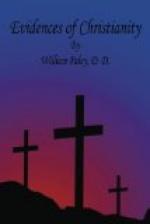If any one choose to call assent to its evidence credulity, it is at least incumbent upon him to produce examples in which the same evidence hath turned out to be fallacious. And this contains the precise question which we are now to agitate.
In stating the comparison between our evidence, and what our adversaries may bring into competition with ours, we will divide the distinctions which we wish to propose into two kinds,—those which relate to the proof, and those which relate to the miracles. Under the former head we may lay out of the case:—
I. Such accounts of supernatural events as are found only in histories by some ages posterior to the transaction; and of which it is evident that the historian could know little more than his reader. Ours is contemporary history. This difference alone removes out of our way the miraculous history of Pythagoras, who lived five hundred years before the Christian era, written by Porphyry and Jamblicus, who lived three hundred years after that era; the prodigies of Livy’s history; the fables of the heroic ages; the whole of the Greek and Roman, as well as of the Gothic mythology; a great part of the legendary history of Popish saints, the very best attested of which is extracted from the certificates that are exhibited during the process of their canonization, a ceremony which seldom takes place till a century after their deaths. It applies also with considerable force to the miracles of Apollonius Tyaneus, which are contained in a solitary history of his life, published by Philostratus above a hundred years after his death; and in which, whether Philostratus had any prior account to guide him, depends upon his single unsupported assertion. Also to some of the miracles of the third century, especially to one extraordinary instance, the account of Gregory, bishop of Neocesarea, called Thaumaturgus, delivered in the writings of Gregory of Nyssen, who lived one hundred and thirty years after the subject of his panegyric.
The value of this circumstance is shown to have been accurately exemplified in the history of Ignatius Loyola, founder of the order of Jesuits. (Douglas’s Criterion of Miracles, p. 74.) His life, written by a companion of his, and by one of the order, was published about fifteen years after his death. In which life, the author, so far from ascribing any miracles to Ignatius, industriously states the reasons why he was not invested with any such power. The life was republished fifteen years afterwards, with the




